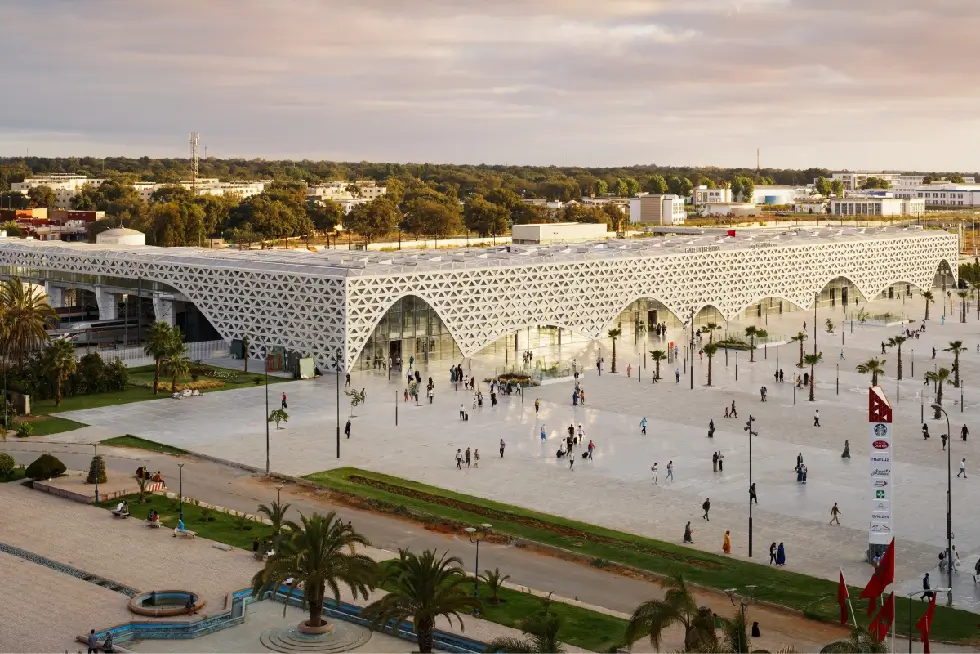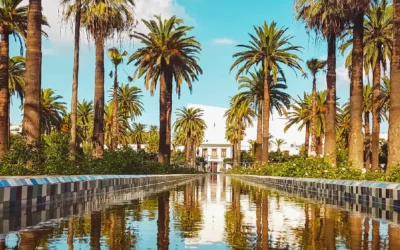Kenitra City: The Gateway to the Atlantic Ocean Through Its Port Of Morocco

Table of Contents:
Introduction To Kenitra City
Kenitra is a city situated on the northwestern shores of Morocco in the Rabat-Salé-Kénitra region. Once known as Port Lyautey, it has transformed from a historic military port into a thriving industrial powerhouse.
Its strategic location on the Atlantic makes it a critical player in maritime trade, bustling with the export of goods like agricultural produce, fish, and minerals.
The city’s charm is further enhanced by its mild Mediterranean climate, making it an inviting destination all year round. Close to beautiful beaches like Mehdia Beach, Kenitra offers the perfect mix of relaxation and adventure.
Established in 1912 as a French military stronghold, it’s a city that has gracefully navigated through numerous cultural and political changes, particularly after Morocco’s independence in 1956. This blend of past and present gives Kenitra its unique flavor.
Kenitra Discovery Tour
Kenitra is a diverse and intriguing destination for visitors looking to explore the depth of Moroccan culture and natural beauty. Here are some places to discover:
1. Mehdia Beach: A Water Sports Haven
Nestled in the northern part of Kenitra, Mehdia Beach stands out as a serene paradise along the Atlantic. This beach is a haven for sports enthusiasts, offering a plethora of activities such as surfing, bodyboarding, diving, and swimming.
For a unique experience, try the camel riding tours. And, don’t miss out on the local seafood served at the beachside restaurants – a true culinary delight!
2. Lac Sidi Boughaba: A Nature Lover’s Retreat
Just 13 km from the heart of Kenitra and close to Mehdia Beach, the Lac Sidi Boughaba natural reserve is a scenic haven perfect for picnics.
This spot is renowned for its exotic birds and tranquil natural beauty, making it an ideal escape for nature lovers.
3. Historical Wonders: Kasbah of Mehdia and Thamusida Ruins
Discover history at the Kasbah of Mehdia, an ancient fortress perched on the Sebou River’s banks, dating back 2000 years.
Nearby, the Thamusida Ruins offer a glimpse into the Roman era with landmarks from around 200 AD, highlighting the region’s rich historical tapestry.
4. Mohammed VI Mosque: Architectural Splendor
In the heart of Kenitra, the Mohammed VI Mosque stands as a modern architectural marvel. Its towering minarets and contemporary Islamic design mark it as a prominent religious and cultural landmark in the city.
5. Kasbah Mahdiyya: A Glimpse into the Past
Close to Kenitra, the Kasbah Mahdiyya, built during the Berber Almohad sultanate and restored in the 17th century, offers insights into the area’s historical significance.
6. Mehdya: A Town Steeped in History
The town of Mehdya, located within Kénitra Province, is a historical treasure trove. Once under Portuguese rule in the 16th century and later the Spanish in the 17th century, Mehdya’s past is as rich as it is intriguing.
Kenitra Accessibility And Transportation
The accessibility and transportation in Kenitra have seen significant advancements, particularly with the introduction of modern infrastructure like the Kenitra High-speed rail station. Here are some key aspects of Kenitra’s transportation and accessibility:
1. High-Speed Rail
Kenitra is served by the high-speed rail network, which is a part of Morocco’s Al Boraq TGV line. This network significantly reduces travel time between major cities, including Kenitra, making it a crucial element in the country’s transportation infrastructure.
2. Rail Station as a Transit Hub
The Kenitra High-speed rail station, a project by Silvio d’Ascia Architecture and Omar Kobbité Architectes, is more than just a train station.
It acts as a transit hub and an essential public space, improving connectivity within the city. This station facilitates easy movement between different parts of Kenitra, especially between new city districts and the historic district.
3. Urban and Architectural Design
The station’s design, inspired by traditional Moroccan architecture and Islamic geometric patterns, is not only aesthetically pleasing but also functional. It helps in managing seasonal temperature variations, making the station environment more comfortable for commuters.
4. Efficient Daily Commute Options
For everyday travel within Kenitra and its suburbs, the city offers a variety of public transport solutions. Buses are known for their affordability and reliability, ensuring residents can easily reach essential services such as schools, shopping centers, and healthcare facilities.
For a more personalized experience, taxis are always at hand. The efficiency of Kenitra’s transportation network simplifies city navigation and accessibility.
5. Prioritizing Safety
Safety is a top priority in Kenitra. The local police are committed to maintaining peace and order, making the city safer than many other Moroccan cities. Visitors and residents alike are encouraged to exercise general caution, especially in crowded spaces and during the night.
Modern Kenitra and its Economic Significance
A. Kenitra: A City Transformed
1. The Emergence of Modern Kenitra
Kenitra has experienced remarkable changes, showcasing its rising economic importance and successful integration into the global sphere.
A standout development in this transformation is the Kenitra High-speed Rail Station, a joint design effort by Silvio d’Ascia Architecture and Omar Kobbité Architectes.
This station is more than a transport hub; it represents Morocco’s socio-economic and technological advancement.
2. Architectural Marvel: Blending Tradition with Modernity
The design of the Kenitra Station artfully combines traditional Moroccan architectural elements with a modern urban setting. Serving as a pivotal public space, it connects various parts of the city.
Its facade is especially striking, drawing inspiration from Islamic geometric patterns. This design creates a harmonious blend of light, shadow, and transparency, significantly contributing to Kenitra’s urban landscape.
B. Regional Integration and Administration
Strategic Governance in the Rabat-Salé-Kénitra Region
Kenitra is a part of the Rabat-Salé-Kénitra region, known for its well-structured service architecture.
This structure includes divisions focusing on the environment, rural affairs, and economic and social development. The region’s dedication to efficient economic governance and sustainable, integrated development is evident.
C. Economic Evolution and Diversification
1. From Colonial Past to Economic Hub
Historically, Kenitra started as a French military fort and town. It has since evolved into a major center for shipping agricultural products, fish, timber, and ores. The industrial area, located upstream of the port, highlights the city’s commitment to economic diversification.
2. Kenitra in the Moroccan Economic Landscape
Kenitra’s integration into Morocco’s wider economic framework is visible through initiatives in construction, tourism, and agri-business, similar to developments in neighboring regions like Fez–Meknes.
These efforts demonstrate the country’s push towards diversification and resilience in its economy, signaling a broader trend of development and modernization.
Kenitra History Overview
A. Kenitra’s Storied Past: From Phoenician Roots to Roman Recognition
Kenitra boasts a rich and diverse history. Its journey began in the Phoenician era as a bustling maritime trading post along the Sebou River.
This period cemented Kenitra as a crucial trade and cultural exchange hub. The Romans succeeded the Phoenicians, further recognizing and enhancing Kenitra (then known as Thamusida) as a pivotal trade center.
B. The French Era: Establishing a New Identity
The turning point in Kenitra’s history came with the establishment of the French Protectorate in Morocco. In 1912, French General Louis Hubert Lyautey founded the city, initially naming it Port Lyautey.
This ushered in a new era of development, transforming Kenitra into an indispensable military and economic stronghold for the French. The 1913 establishment of the port and settlement by Marshal Lyautey was a key milestone in reinforcing its strategic importance.
C. A New Chapter: Post-Independence Transformation
Post-Moroccan independence in 1956 marked a significant shift. The renaming of the city from Port Lyautey to Kenitra symbolized a new chapter, mirroring Morocco’s evolution from a French protectorate to an independent nation.
This name change was more than symbolic; it represented a reclaiming of identity and heritage.
D. Kenitra Today: A Fusion of History and Modernity
Today, Kenitra’s strategic position at the Sebou River mouth and its closeness to Rabat, Morocco’s administrative capital, continue to make it a vital industrial and agricultural hub. The city’s growth reflects a unique fusion of historical richness and modern development.
It stands as a testament to its diverse cultural and historical influences, embodying a blend of historical significance and contemporary progress.
Conclusion
Kenitra stands as a beacon of Moroccan culture and progress. Cradled by the Sebou River, this city is a harmonious blend of historical charm and modern development. It’s a place where tradition and innovation coexist, offering a unique and memorable experience to all who visit.
As we bid farewell to Kenitra, we carry with us the vibrant images of its lively streets, peaceful riverbanks, and the warm spirit of its people, a testament to the enduring allure of this Moroccan jewel.
FAQ
What is the climate like in Kenitra?
Kenitra has a mild Mediterranean climate, making it an inviting destination throughout the year.
What is Kenitra known for?
Kenitra, once called Port Lyautey, is known for being a historic military port, now a thriving industrial city in Morocco. It’s significant in maritime trade, exporting goods like agricultural produce, fish, and minerals.
Where is Kenitra located?
Kenitra is located on the northwestern shores of Morocco, in the Rabat-Salé-Kénitra region.
Are there any beaches near Kenitra?
Yes, Mehdia Beach is a popular beach close to Kenitra, known for its water sports and relaxing environment.
What is the historical significance of Kenitra?
Established in 1912 as a French military stronghold, Kenitra has a rich history, having navigated through various cultural and political changes, especially after Morocco’s independence in 1956.
What are some must-visit places in Kenitra?
Notable places include Mehdia Beach, Lac Sidi Boughaba, Kasbah of Mehdia, Thamusida Ruins, Mohammed VI Mosque, and Kasbah Mahdiyya.
How is Kenitra connected by rail?
Kenitra is part of Morocco’s Al Boraq TGV high-speed rail network, significantly reducing travel time to major cities.
What is unique about the Kenitra High-Speed Rail Station?
The station is a blend of modern architecture and traditional Moroccan design. It’s a key transit hub, connecting different parts of the city and enhancing public space.
What are the daily commute options in Kenitra?
Kenitra offers buses for affordable and reliable travel, and taxis for a more personalized experience.
How has Kenitra evolved economically?
Kenitra has transformed from a French military town to a major center for shipping and industrial activities. It’s a crucial part of Morocco’s economic framework, with a focus on diversification in sectors like construction, tourism, and agri-business.
What does the history of Kenitra encompass?
Kenitra has a storied past from the Phoenician era to Roman times, later becoming an important French military and economic stronghold. Post-independence, it transformed into a symbol of Morocco’s reclaimed identity and heritage.
How does modern Kenitra represent its history and progress?
Modern Kenitra reflects a fusion of its historical significance and contemporary development, exemplifying a mix of cultural and historical influences.



